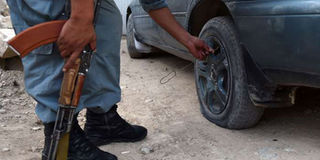Afghan police ‘novel’ way to stop car theft

Afghan police officials stand beside a vehicle whose tyres they are deflating on a street at Khair Khana in Kabul on August 23, 2016. Officers used to simply slash the tyres, but now take the slightly more considerate route of removing air nozzles. PHOTO | AFP
What you need to know:
- Data shows up to 300 cars were stolen in Kabul between March and July — slightly down from last year.
- But the tactic has angered a public frustrated with the inconvenience and burden of repeated repairs.
KABUL
Police patrol the Afghan capital on a warm Sunday, but not to hunt extremists.
Instead, they are deflating the tyres of parked cars — a theft prevention tactic that is raising eyebrows as the country struggles to contain the growing menace of petty crime.
Kabul and its estimated five million inhabitants are at war, a prime target for Taliban-led insurgent attacks as well as assaults by a nascent Islamic State.
The capital’s fledgling police force is under pressure to prevent atrocities, so — short on time and resources — they have taken a scorched earth approach when it comes to tackling more routine petty crime.
The logic is indisputable: if the car cannot be moved, it cannot be stolen.
“Police politely ask the residents to not park their cars in the open... but when they prefer to pay no heed, then police may move in to remove the air nozzles as a last measure,” says Feraidoon Obaidi, chief of Kabul police’s criminal investigation department.
“We can protect people from thieves and the terrorists.”
Data shows up to 300 cars were stolen in Kabul between March and July — slightly down from last year.
“In some cases, they work in gangs while others work individually snatching cars, especially the ones that can easily be unlocked,” says Kabir Ahmad Barmak, chief of Kabul’s eleventh district police.
“They take cars parked in vacant streets, especially at night, and sometimes turn them into spare parts,” Barmak says, adding police use valuable resources on special mobile patrols to tackle the problem.
Officers used to simply slash the tyres, but now take the slightly more considerate route of removing air nozzles.
“When you see thieves lurking in dark and people recklessly leaving their cars in the open, it makes you think, best way to protect is to damage the tyres,” says another officer in the district.
But the tactic has angered a public frustrated with the inconvenience and burden of repeated repairs.
“Should one expect the police to serve or to hurt?” asks Akbar, a customer at a tyre repairing unit on the roadside.
“It is not fair to puncture a car to avert theft... You park your car here for few minutes, it is either stolen by a thief, or damaged by police,” he says. “That is vandalism, not service.”
Others pointed out they had little option but to leave their cars in the open.
“When you go to the city, there are not many places to park your car except the streets, and then it is gone without much hope for its recovery,” says Ahmad Shoaib, whose car was stolen last month.
But there is one merry, busy segment of the capital that appears to appreciate the situation.





